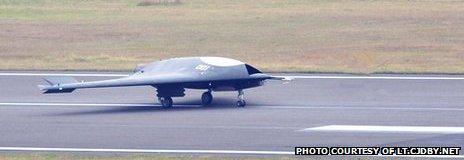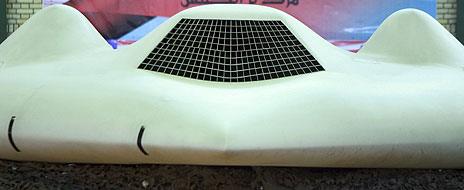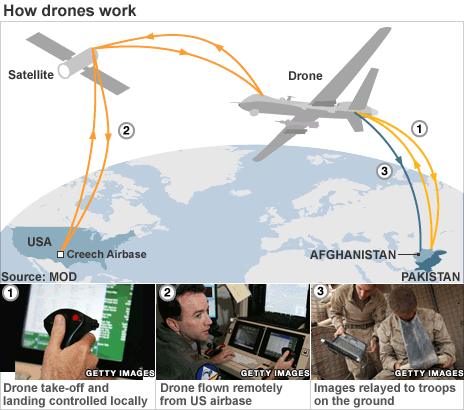The world's proxy drone wars
- Published

The Chinese drone bears a resemblance to its American cousin
China's new stealthy unmanned aerial vehicle (UAV), dubbed Sharp Sword by the domestic media, shows its eagerness to catch up in the field of drone technology.
It bears a striking similarity in its overall shape to the bat-winged RQ-170 Sentinel, built by the US company Lockheed Martin and operated by the Americans since around 2007.
China is thus well-behind the Americans but is fast developing an impressive UAV capability of its own.
Little is known about the precise specifications and capabilities of the Chinese drone.
What is clear from recent air shows and the Chinese technical press is that China has developed a variety of UAVs matching virtually every category deployed by the US.
They range from small tactical drones of limited endurance to much larger systems that look strikingly like US Reaper or Predator models, and just like their US counterparts some of these Chinese drones are equipped with hard-points on their wings to carry munitions.

An RQ-170 Sentinel was famously captured by Iran in 2011
The two leading players in the drone club - the US and Israel - have developed UAVs for a variety of purposes. These range from intelligence-gathering to strikes against targets on the ground.
Not surprisingly, China sees UAVs in exactly the same light.
UAVs are fast becoming an especially useful tool for Beijing in monitoring activity over contested areas of the South China and East China Seas.
They are also an easy way to demonstrate presence in a disputed zone. China is believed to have converted a number of out-of-date J-6 fighters into UAVs, which may well be being used to monitor the disputed Diaoyu/Senkaku Islands.
Japan hopes to deploy advanced US-built drones for similar surveillance purposes.
China also has the ability to arm some of its drones. Earlier this year, an interview in the Chinese Global Times newspaper provided a striking insight into Beijing's thinking about drones.
A senior official in the public security ministry's anti-drugs bureau acknowledged that China had considered using an armed drone against a wanted drug trafficker in northern Burma, also known as Myanmar.
This particular individual was alleged to have been behind an attack that killed 13 Chinese sailors.
In the event the attack was never carried out, but the clear implication is that Beijing has drawn some conclusions of its own from Washington's use of UAVs to take out targets across borders.

The "war on terror" has highlighted the use of UAVs in very particular circumstances; largely in clear skies and operating in areas devoid of modern air defences.
When drones have been used in other circumstances, such as Georgia's brief conflict with Russia back in 2008, Georgia's Israeli-supplied drones were simply shot out of the sky.
Today even senior US commanders are wondering if the drone programme's ambitions need to be scaled back. It is not that they are not a useful capability, but the circumstances of future conflicts may leave them much more vulnerable.
This is perhaps one of the reasons that the US, and now China too, is seeking to operate stealthy UAVs.
The other reason for the significance of China's UAV programme is its implications for the proliferation of such technology around the world.
US drones are state-of-the art and very expensive, even if a country gets security clearance to actually buy them. The US Reaper has a price tag of some $30m.
But Beijing's drones come at bargain prices. The Chinese Wing Loong - probably less capable than the Reaper but nonetheless broadly similar - can be yours for about $1m.
China has fewer technology export controls is especially eager to sell small or medium-sized drones in the Asian and African markets.
In addition, this is a market that goes way beyond the military, with law-enforcement and environmental agencies for example eager to employ relatively cheap UAV technology.
- Published22 November 2013
- Published31 October 2013
- Published14 October 2013
- Published31 January 2012